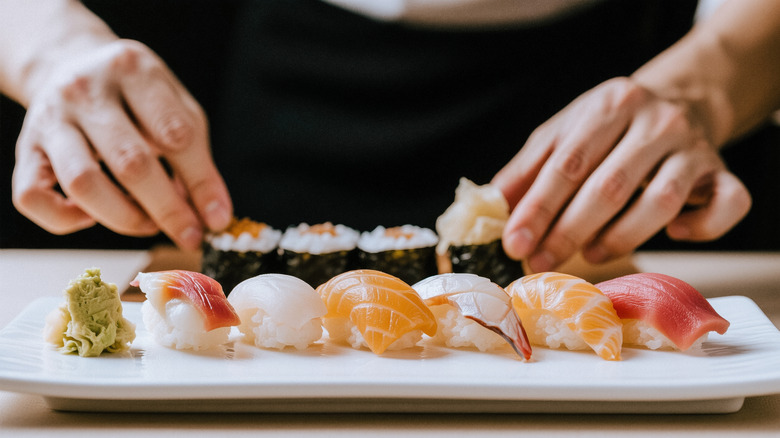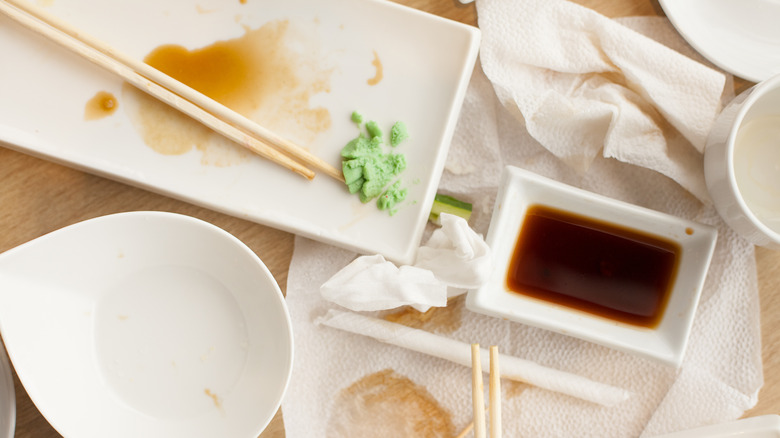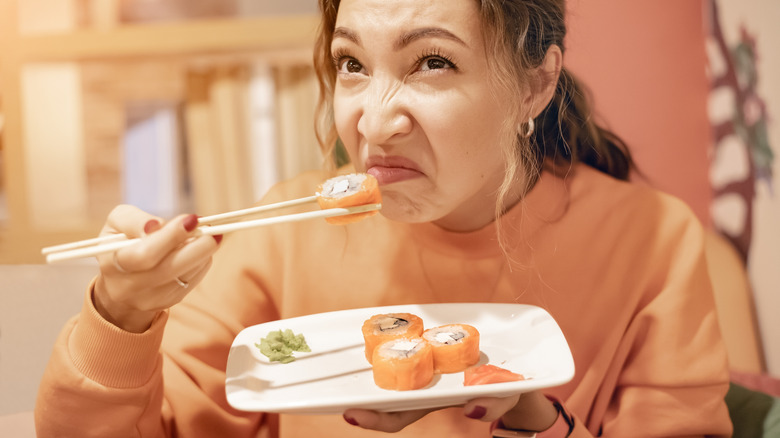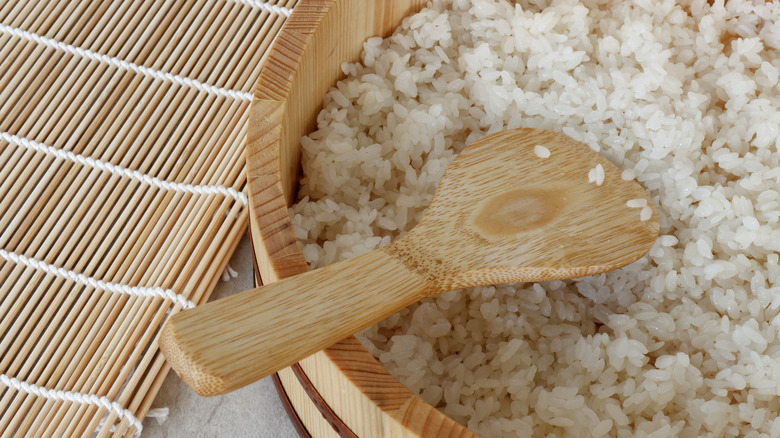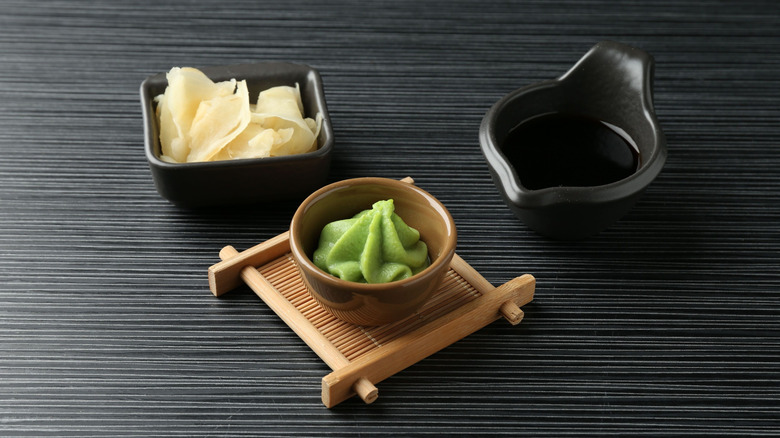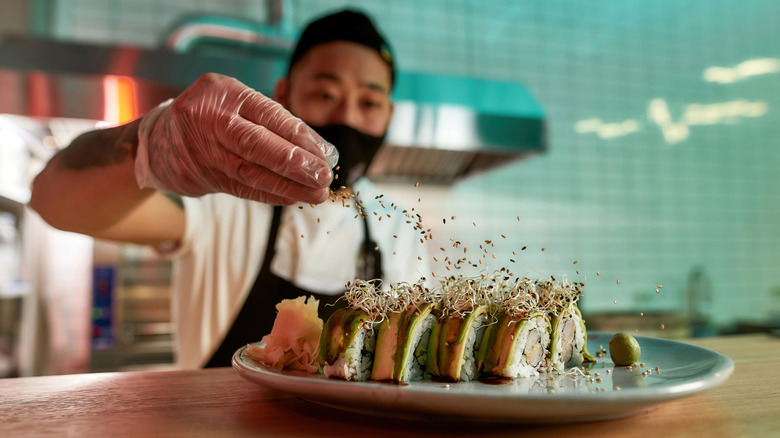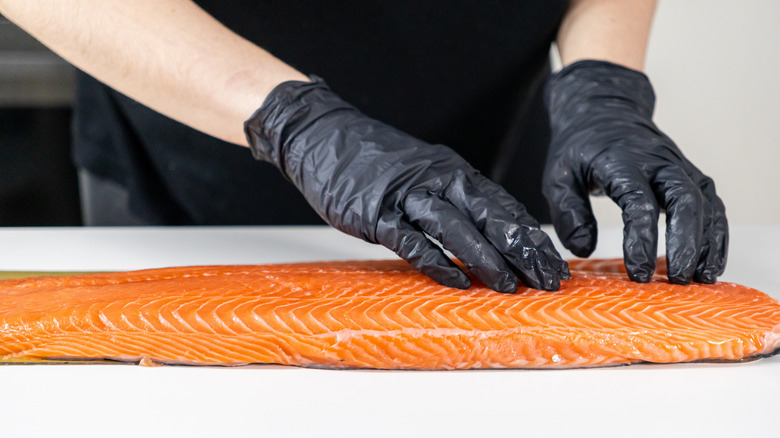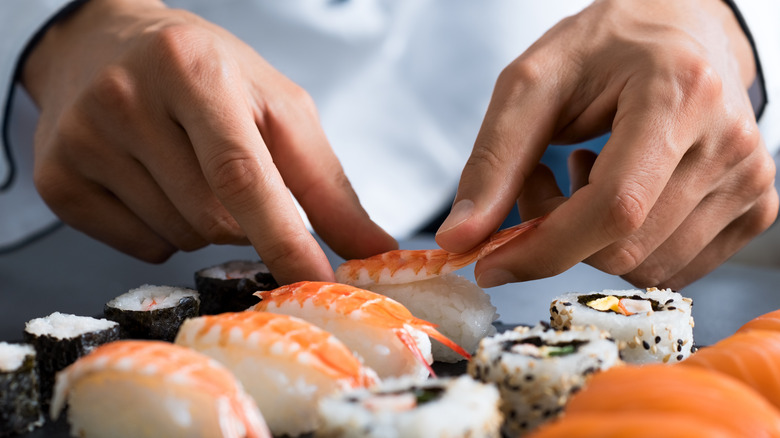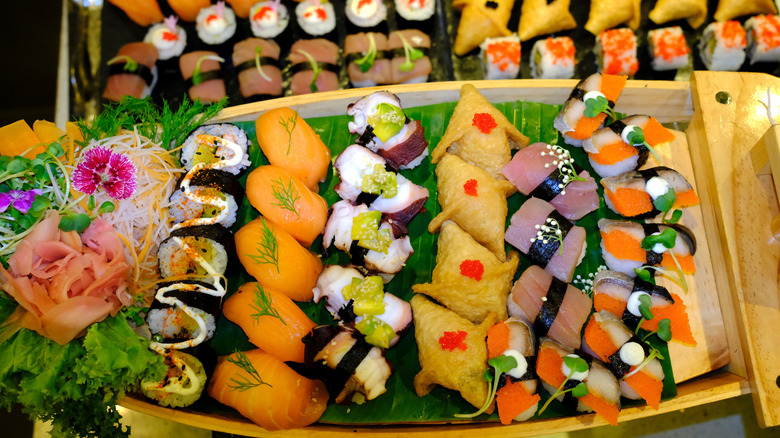Sushi Restaurants Red Flags To Keep On Your Radar
Visiting a new sushi restaurant is a gamble. When you find a winner, that memorable meal leaves you satisfied for days. But when you don't? The subpar sushi doesn't just feel like a waste of money, but can leave your digestive system suffering. Luckily, there are telltale signs that can help you avoid risky establishments.
To understand the subtle clues, we consulted two sushi experts. Christopher Stout has decades of experience in the sushi industry and is currently the Chef-Owner of the well-reviewed Isekai Sushi and Cafe. Also joining us is Kenji Sawada, Executive Sushi Chef at the upscale KAIYO SF, known for serving incredible Nikkei cuisine at an intimate sushi bar.
Together, these experts detail the red flags every sushi lover should recognize. So before splurging on that fancy sushi bar or trying that suspiciously affordable neighborhood joint, keep reading — and consider this guide your cheat sheet. Because while some gambles are worth it, life's too short for subpar sushi!
The restaurant smells bad
A foul odor is an obvious red flag at a sushi restaurant. While fish naturally carry an oceanic aroma, there's a definitive line between smelling fresh-from-the-sea and past-its-prime. "The smell should be similar to a clean ocean scent," Stout explains. "If it smells overly 'fishy,' that's a bad sign." More concerning is the "strong chemical or bleach smell" that can accompany old seafood. Not only is this unappetizing, but it can also be a serious health risk.
Expired fish isn't the only olfactory warning. As Sawada shares, "I think sushi restaurants that smell like vinegar aren't clean enough." Additionally, musty or pungent odors can signal a dirty environment. In a well-run restaurant, trash is removed and surfaces are cleaned before your nose can detect any problem. Since a good sushi experience starts with smell, trust your gut! If something smells fishy, it probably is, so spare your wallet and stomach by dining elsewhere.
The restaurant is dirty
When choosing a sushi restaurant, your nose isn't the only detector worth trusting. Your eyes are also a valuable tool, so pay attention to cleanliness. A clean establishment isn't just about aesthetic — it shows the staff takes pride in their restaurant, and a team that celebrates cleanliness is more likely to bring that same attention to your sushi orders.
Do a quick scan when you walk into a restaurant. Are the floors suspiciously sticky? Tables still messy from previous diners? These are instant red flags. Dirty dishes shouldn't be camping on surfaces, and you shouldn't be able to write your name on dust anywhere. Even the little things — like that smudged glass or dirty restaurant menu – speak volumes about what's happening behind the scenes.
The standards for the front of house reflect those hidden in the kitchen. An establishment that compromises on cleanliness is probably cutting corners elsewhere — like with proper storage temperatures or cross-contamination prevention. Not exactly what you'd want in a place handling your raw fish!
The fish isn't fresh
Imagine the disappointment: You've bitten into your much-anticipated sushi roll only to encounter fish with a slimy texture or pungent taste. Besides ruining your meal, these qualities are telltale signs your seafood isn't fresh, which can pose serious health risks.
How can you tell your fish is bad before diving in? Smell is an obvious indicator. As Stout describes, "If [the fish] tastes off, or strong, especially like ammonia, it's spoiling." This ammonia scent isn't just unpleasant; it's chemistry at work. When fish deteriorate, a compound called trimethylamine oxide breaks down into ammonia derivatives, creating that unmistakable warning sign sushi lovers recognize immediately.
However, Sawada cautions that identifying spoiled seafood isn't always this straightforward. "Some fish may not smell fishy, though they still may not be fresh, so it's important to look at the other qualities as well." This is where visual and tactile assessments are crucial. Stout describes that "Fresh sushi fish should be firm, not mushy and slimy ... The color should be vibrant, not dull." Begin with nigiri or sashimi and apply gentle chopstick pressure to gauge texture while examining its color. Remember that each species looks different — premium raw salmon should be a bright red-orange, yellowtail appears light pinkish-white, and bluefin tuna ranges from pink to deep red.
Staff aren't knowledgeable about the sushi
When exploring unfamiliar sushi territory, restaurant staff should be your guide. Staff expertise varies by establishment, but even casual spots should employ individuals who can answer simple questions and offer recommendations. As Stout notes, "They should definitely know the basics. What kind of fish is served, where it comes from, flavor profiles ... They also should know about various allergens, how [the sushi] is prepared, and so forth." This knowledge isn't just courteous, but it's also crucial for making educated dining decisions.
Sawada's expectations vary depending on the establishment. "In fine dining restaurants, it's a good idea for servers to be able to tell customers the name and origin of the fish they serve, but I don't think it's mandatory in mid-level or lower restaurants." This nuanced approach makes sense. You wouldn't expect a server at your neighborhood sushi counter to have the same expertise as an omakase chef.
Wherever you dine, don't be afraid to engage with the staff. Their responses reveal the restaurant's dedication to staff education, and you might even discover your next favorite dish. Just remember to keep an open mind when asking for suggestions. After all, not trusting your sushi chef's recommendations is just one of the mistakes people make when ordering sushi.
The restaurant offers unsuitable types of seafood for sushi
Not all seafood belongs on your sushi platter. Certain varieties require extra careful sourcing or preparation methods to prevent digestive disasters. Stout is wary of restaurants serving escolar, as its "high oil content is known to cause digestive issues." Escolar's nickname, "ex-lax fish," suddenly makes sense. Even the Queensland Government warns consumers that this fish species causes stomach issues, including oily diarrhea, in up to 67% of those who consume it. While not life-threatening, it's definitely uncomfortable. Worse yet, escolar is often deceptively mislabeled as butterfish, white tuna, or super white tuna.
Stout also advises avoiding raw mussels and clams as they "can also be troublesome with bacteria when served raw." You might want to exercise caution with cooked varieties as well — these shellfish are notoriously tricky to prepare correctly, with mistakes leading to stomach upset or food poisoning. Even Anthony Bourdain wouldn't order mussels at restaurants unless he knew the chef well.
Conventionally safe fish also require proper sourcing. Sawada notes that "wild caught fish have a high risk of parasites, so it's best to buy them from a knowledgeable dealer or fisherman." When in doubt, ask staff about the specific fish species and its origin.
The rice is clumpy, cold, or flavorless
Fish isn't the only ingredient you should pay attention to when looking for sushi red flags. Rice is actually the foundation of this culinary art form. What gives away bad sushi rice? "Rice that looks clumpy and dry, or bloated and puffy, is a good indication that it's not cooked and/or taken care of correctly," Stout explains. Instead, look for rice that's "slightly warm, with a firm pearliness and [is] moist and tender on the inside." He paints a picture of a bite that's just right, describing the rice's ideal flavor balance of sweet and tart notes, and saying that each grain should be tangible on your tongue.
Ever bitten into cold, flavorless rice? It tastes as if it was prepared ages ago and left sitting out. Aside from tasting terrible, this approach can actually make you sick. As Sawada warns, "Depending on the environment and containers used when storing it, there is a risk of bacteria and E. coli multiplying. For example, direct sunlight, hot and humid places, unsanitary containers, and unsanitary chefs' hands can all contribute to the spread of bacteria and E. coli." Cooked rice also creates an ideal breeding ground for Bacillus cereus bacteria, a common culprit of food poisoning.
The accompaniments aren't fresh or flavorful
Every great sushi experience includes the right supporting players — in this case, wasabi, ginger, and soy sauce. How can you use these to assess a quality restaurant? As Stout notes, "Having real wasabi or fresh grated wasabi can be a good indication, along with a good horseradish substitute." Authentic wasabi, freshly grated from the root, delivers a complex, fleeting heat. Its more common doppelgänger, made from horseradish and food coloring, lingers longer on your palate and offers a sharper bite. Both can signal an excellent restaurant, assuming they taste vibrantly fresh. Anything with muted flavors is a giant red flag.
Soy sauce and ginger can also be quality barometers. Stout recommends seeking "Full tasting and balanced soy sauce, and white ginger that is also balanced and mildly sweet." Both white and pickled pink ginger can be natural, high-quality sides. But unfortunately, some versions of pink ginger use artificial colors, giving it what Stout describes as "a mild chemical unnatural taste." If picking up on this flavor, the restaurant is likely using a cheaper, store-bought variety.
Finally, don't panic if the accoutrements aren't what you expected. It might simply point to cultural authenticity. As Sawada explains, "In Japan, nigiri sushi is generally served with wasabi inserted between the fish and rice, so we don't offer it to customers on the side. As for pickled ginger, we offer it to reset and cleanse the palate, but I don't think it's absolutely necessary."
The sushi comes with too many ingredients
Good sushi is all about simplicity, and quality ingredients will speak for themselves. So when menu items read like a party on your plate, the restaurant might be overcompensating for subpar sushi. As Stout observes, "When presenting their rolls, if it is drowning in generic sauce or has an excessive amount of toppings like tempura chip, green onions, smelt roe, especially all at once, it really is a red flag."
The problem isn't merely aesthetic. With too many competing elements, Stout explains, "You really can't taste what you're eating. You begin to lose the flavor of the fish or main ingredients. Balance truly is the key." Similarly, be wary when too many menu items feature cream cheese as a key ingredient. While Philadelphia rolls have their devoted fan base, a menu where cream cheese appears more frequently than fish has deviated a bit too far from its traditional roots.
The sushi hasn't been deboned properly
Nothing destroys a sushi meal faster than a dental disaster, which is exactly what you'll get if you bite into unexpected bones or shells. Mind you, this never should have happened in the first place. Professional sushi chefs undergo significant training in fish preparation, learning how to meticulously fillet, skin, and debone each specimen before serving it.
"One thing I am careful about with ingredients is whether any bones or shells are left behind," Sawada emphasizes, "as these can obviously be dangerous. They can chip teeth or get stuck in the throat." At best, you'll notice these bony intruders immediately and fish them out of your sushi. However, it's not just about the inconvenience. Unwelcome fish parts on your plate point to a negligent kitchen where the staff may be rushed or have inadequate training. Either way, crucial details are being overlooked, and when it comes to sushi, these details matter.
The menu is enormous
A jack of all trades is a master of none, and the same logic should be applied to restaurants. Long restaurant menus are red flags because it's hard for chefs to hone their craft without specializing in a specific cuisine. Plus, it creates food safety concerns. Serving everything from pasta and sandwiches to sushi and salads means the kitchen is juggling a vast array of ingredients. This can make proper food handling practices challenging, increasing the risk of foodborne illnesses. This is even more concerning when dealing with delicate ingredients that are served at room temperature, like raw fish and sushi rice.
Sushi and burgers shouldn't be on the same menu. Considering they are polar opposite dishes, you can't help but question the quality of each when you see them side-by-side. Aside from these quality concerns, such diverse choices are overwhelming for restaurant patrons. An obnoxiously long menu causes serious analysis paralysis, while a shorter, well-executed menu is far more likely to deliver top-notch cuisine. So if you open a menu to find sushi next to pizza, lower your expectations.
You can't see the sushi being made
An open kitchen is a hallmark of authentic sushi restaurants. It isn't just about transparency — it also provides a window into the artistry of sushi making. Watching the sushi master at work allows you to verify that they use fresh, quality ingredients and proper hygiene practices. Stout elaborates, "Transparency builds trust. A clean and organized setup shows pride and professionalism ... A sushi-ya (sushi restaurant) or restaurant that makes the sushi behind walls where you can't see them means it's an afterthought and not taken seriously."
Creating quality sushi isn't solely about providing sustenance; it's an art form that deserves appreciation. So take a front row seat and don't worry about making the sushi master uncomfortable — they know how to "roll" with it! They might even thrive in the limelight. As Sawada notes from experience, "The chef will feel more focused and will be able to concentrate on their work when they are being watched by the customers."
Prices are too good to be true
Extremely low prices at sushi restaurants should raise alarm bells. Sushi commands high prices for good reason — quality ingredients and skilled labor cost more. Fresh fish is expensive and, depending on location, it may need to be flown in. Beyond disappointing your palate, cheaply-made sushi may pose genuine health risks. As Sawada notes, "From my experience, some cheap restaurants may not be serving safe food, depending on the chef's level of expertise."
Ultimately, you get what you pay for. Stout shares this sentiment, explaining, "Cheaper products give lackluster experiences, taste, and textures ... Very low prices usually mean shortcuts, pre-cut ingredients, or low-grade products." He's seen this play out firsthand, explaining, "Many sushi bars have switched to bulk frozen tuna saku (carbon monoxide treated tuna). It's less than half the price of my fresh tuna and lacks [the] depth and dimension of fresh tuna."
It's a sushi buffet
Tempted by an all-you-can-eat sushi buffet? Before you roll the dice, consider what you're really getting for your money. While these meals may seem like a steal, sushi experts are divided. And ultimately, we'd approach them with caution.
Stout isn't a fan, explaining, "Personally, I stay away from buffet sushi. Just about all of them use cheaper products. Even before sitting out too long, cheaper products always tend to have muted flavors [and] colors and mushy textures."
Timing is everything when it comes to sushi, and that fresh factor quickly disappears when the fish is exposed to the elements. As Stout notes, "Once sitting for an hour, the rice gets dry and hard. If the tray is not rotated out, the product just 'dies' and gets worse the longer it sits." If buffets still float your boat, do your research before diving in, and watch for these buffet red flags you should never ignore, like off-colored seafood and incorrect temperatures.
The restaurant isn't well-reviewed
The biggest indicator of future behavior is past behavior, and sushi restaurants are no exception. A restaurant's review history provides invaluable information about what awaits you. However, don't panic over one negative review (even sushi masters have off days). Instead, pay attention to concerning patterns like a recent cascade of 2-star ratings or repeated mentions of poor service or subpar sushi. And if multiple reviewers warn against that dragon roll, take a hint!
A lack of reviews can be just as revealing as bad ones. That brand new spot deserves the benefit of the doubt, but an established restaurant with barely any feedback is a red flag. Think about it: Remarkable experiences, good or bad, inspire people to share. No reviews usually means there was nothing memorable about the meal.
Before shelling out money for a sushi experience, do your research. Check out Yelp, Google Reviews, and TripAdvisor for the inside scoop. These past reviews give you an idea of what to expect (and what to order), which is especially important before eating at a sushi buffet, where previous diners' experiences can tell you if that all-you-can-eat deal is actually worth it.
